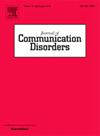同伴对唇腭裂儿童的态度:视觉和听觉线索的相互作用?
IF 2.1
3区 医学
Q2 AUDIOLOGY & SPEECH-LANGUAGE PATHOLOGY
引用次数: 0
摘要
背景与目的对于伴有或不伴有唇裂的腭裂相关言语障碍儿童(CP±L),有效的沟通是一个重大挑战。听者经常根据语音信号形成判断,从而导致污名化和负面刻板印象。当一个孩子也患有唇裂时,认知可能会进一步受到影响。有限的研究利用视听刺激探讨了同伴对CP±L个体的态度。本研究旨在探讨儿童对CP±L儿童的同伴态度,分析这些态度如何根据听觉、视觉、视听线索和唇裂类型而变化。此外,言语可理解性,言语可接受性和社会接受度之间的关系进行了评估。方法收集11例白种人腭裂儿童(CP)、唇腭裂儿童(CLP)和正常发育的非腭裂儿童(3例)的音频、照片和视听资料。这些刺激由48名7 - 12岁的正常发育同伴(24名男孩,24名女孩)根据三种态度成分,即认知、情感和行为来判断。他们还评估了语音的可理解性和可接受性。计算了态度成分与言语可理解性/可接受性之间的相关性。验证了媒介对每个裂隙类型的同伴态度的影响。结果各态度维度与同伴平均语音可理解性和语音可接受性得分呈显著正相关,尤其是音频和视听样本。异常言语(音频)对所有同伴的态度都有负面影响,而面部表情的变化(照片)对同伴的态度没有实质性的影响。当言语和外表相结合(视听)时,言语偏差对认知态度产生负向影响,而外表变化没有实质性影响。当言语异常并伴有唇裂时,情感态度和行为态度均受到负向影响。结论本研究强调了从多维角度理解和改善同伴对CP±L儿童的态度的重要性。同时解决唇裂相关障碍的听觉和视觉方面的问题可以更好地支持这些儿童的社会融入和福祉。进一步的研究应该探索言语、心理干预和教育计划对同伴态度的长期影响,并检查特定的视觉线索在社会认知中的作用。本文章由计算机程序翻译,如有差异,请以英文原文为准。
Peer attitudes towards children with cleft lip and palate: An interaction of visual and auditory cues?
Background and aims
For children with speech disorders related to cleft palate with or without cleft lip (CP±L), effective communication presents significant challenges. Listeners often form judgments based on the speech signal, contributing to stigmatization and negative stereotyping. When a child also has a cleft lip, perceptions may be further influenced. Limited research has explored peer attitudes towards individuals with CP±L using audiovisual stimuli. This study aimed to examine peer attitudes of children towards children with CP±L, analyzing how these attitudes vary based on auditory, visual, and audiovisual cues and cleft type. Additionally, the relationship between speech intelligibility, speech acceptability, and social acceptance was evaluated.
Method
Audio samples, photographs, and audiovisual samples were collected from 11 Caucasian children: four with cleft palate (CP), four with cleft lip and palate (CLP) and three typically developing children without cleft. These stimuli were judged by 48 typically developing peers aged 7 to 12 (24 boys, 24 girls) based on three attitude components, i.e. cognitive, affective and behavioral. They also rated speech intelligibility and acceptability. Correlations were calculated between the attitude components and speech intelligibility/acceptability. The impact of the medium on peer attitudes per cleft type was verified.
Results
Strong and significant positive correlations were found between all attitude dimensions and the mean speech intelligibility and speech acceptability scores given by peers, particularly with audio and audiovisual samples. Deviant speech (audio) negatively influenced all peer attitudes, whereas variations in facial appearance alone (photo) did not substantially impact peer attitudes. When speech and appearance were combined (audiovisual), deviant speech negatively influenced cognitive attitudes without substantial impact of variation in appearance. Affective and behavioral attitudes were negatively influenced when deviant speech was present in combination with a cleft lip.
Conclusion
This study underscores the importance of multidimensional approaches to understanding and improving peer attitudes towards children with CP±L. Addressing both auditory and visual aspects of cleft-related disorders can better support these children's social inclusion and well-being. Further research should explore the long-term impact of speech and psychological interventions and educational programs on peer attitudes and examine specific visual cues' roles in social perceptions.
求助全文
通过发布文献求助,成功后即可免费获取论文全文。
去求助
来源期刊

Journal of Communication Disorders
AUDIOLOGY & SPEECH-LANGUAGE PATHOLOGY-REHABILITATION
CiteScore
3.30
自引率
5.90%
发文量
71
审稿时长
>12 weeks
期刊介绍:
The Journal of Communication Disorders publishes original articles on topics related to disorders of speech, language and hearing. Authors are encouraged to submit reports of experimental or descriptive investigations (research articles), review articles, tutorials or discussion papers, or letters to the editor ("short communications"). Please note that we do not accept case studies unless they conform to the principles of single-subject experimental design. Special issues are published periodically on timely and clinically relevant topics.
 求助内容:
求助内容: 应助结果提醒方式:
应助结果提醒方式:


